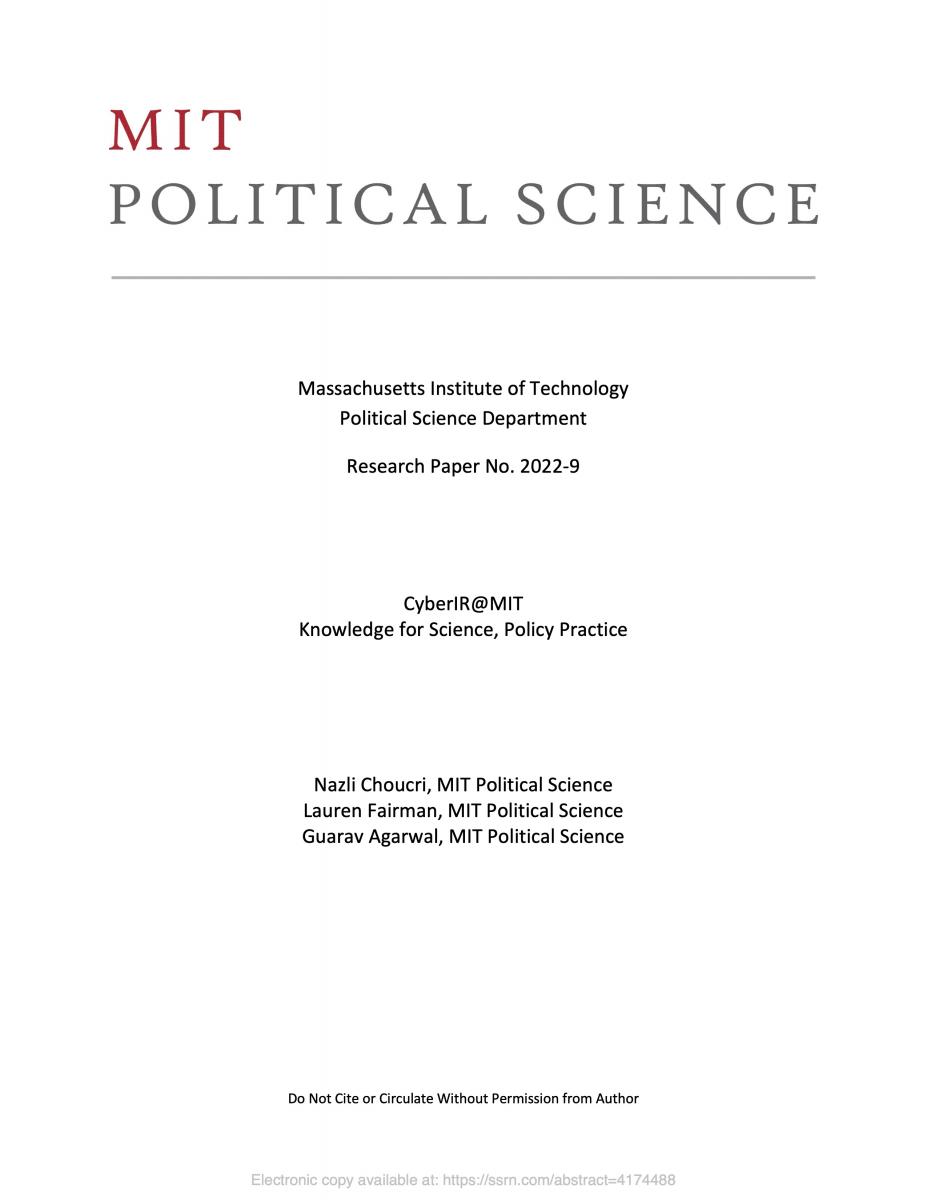See below Expanded Domain ontology for Cyber-IR
Dimension 1 -- System State:
1.1. Cyber-IR System
- A. Internet—Layers
- 1. Physical Layer
- 2. Logical Layer
- 3. Information Layer
- 4. People & Users Layer
- B. International Relations (IR)—Levels
- 1. Levels of Analysis
- 2. Cross Level Actors & Entities
- 3. Cross Level Activities
- 4. Other
- C. Supply Chain
- 1. Contents & Components
- 2. Sources, Locations & Owners
- 3. Trade & Transactions
- 4. Uncertainties, Problems, Barriers
- D. Standards
1.2. Intersection of Layers & Levels
- A. Types of Intersection
- 1. Features & Salience
- 2. Infrastructure & Communication
- 3. Management & Governance
- 4. Jurisdictions & Locations
- B. Internet institutions & Decision Entities
- 1. Innovators, Technologists & Protocol Design
- 2. Operators, Routing & Supports
- C. International Relations (IR) Institutions & Decision Entities
- 1. State Actors & Institutions
- 2. International & Regional Entities
- 3. Market, Industry, Business & Non-State Actors
- 4. Other
- D. Interactions across Levels & layers
- 1. Drivers of Interactions
- 2. Actors & Interests
- 3. Relevance & Impacts
- 4. Other
1.3. Cyber-IR Actors & Activities
- A. Individual & Groups
- B. State Users & Activities
- 1. Governance & Regulation
- 2. Defense & National Security
- 3. Services Provision
- 4. Regulation, Extraction & Other
- C. International Actors & Activities
- 1. Coordination of Cooperation
- 2. Supports for Institutions & Missions
- 3. Policy Development
- 4. Outreach & Other
- D. Innovations and Innovators
1.4. Global Actors & Entities
- A. Anonymous
- B. Formal & Informal
- C. Illegitimate
- D. Other
Dimension 2 -- Problems for Cyber–IR System:
2.1. Threats to Layers
- A. Physical Systems & Operations
- 1. Cables, Wires, Infrastructure
- 2. Network Systems
- 3. ICT Attacks Vectors
- 4. Supply Chain, Industrial Trade Threats
- B. Cyber Security Threats & Transgressions
- 1. Malware & Malicious Code
- 2. Bypass-Security Modes
- 3. Overt Conduct of Damage
- 4. Other
- C. Threats & Damage to Information
- D. Threats to People & Users
2.2. Threats to Levels
- A. Individuals & Groups
- 1. Threats to Cyber Access
- 2. Identity Loss
- 3. Threats to Privacy
- 4. Other
- B. State Level Targets & Damages
- 1. Critical Infrastructures
- 2. Defense Infrastructure
- 3. Industry & Manufacturing
- 4. Other
- C. International Disruptions
- D. Global Risks & Disruptions
2.3. Threats at Intersections of Systems
- A. Physical
- B. Computational
- C. Operational
- D. Policy
2.4. Loss of Value—Layers & Levels
- A. Productivity, Time & Money
- 1. Information Loss
- 2. Loss of National/Business Secrets
- 3. Loss of Value
- 4. Other
- B. Physical System Loss
- C. Transactions & Investments
- D. Loss of Legitimacy
Dimension 3 -- Technological & Scientific Responses:
3.1. Layers of Internet
- A. Physical Layer
- B. Supply Chain Structure & Management
- C. Network Security
- 1. Enhanced Authorization
- 2. Security at Control Points
- 3. Security of Exchange Points
- 4. System Resilience
- D. Integrated Risk Management
- 1. Prevention
- 2. Risk Assessment
- 3. Early Warning Systems
- 4. Capability & Response
3.2. Levels of International Relations
- A. Security of Critical Infrastructure
- B. Security of Human Wellbeing
- C. Environmental Security
- D. Cybersecurity
3.3. Computer Network Defense
- A. Defense Analysis
- B. Infrastructure
- C. Data Protection
- D. Cryptography
3.4. System Resilience
- A. Anticipation
- B. Adaption
- C. Innovation
- D. Organization
Dimension 4 -- Socio-Economic & Political Responses:
4.1. Individuals & Group Level
- A. Situation Awareness
- B. Information Sharing
- C. Contentions & Conflict
- D. Other
4.2. State Level
- A. Legal and Regulatory Systems
- 1. Communication & Cyber Law
- 2. Contract & Commercial Law
- 3. Consumer Protection Law
- 4. Civil & Criminal Law
- B. Capacity Building & Social Capital
- 1. Encryption Capability
- 2. Machine Learning & Artificial Intelligence
- 3. Digital Rights
- 4. Other
- C. Business & Non-State Initiatives
- 1. Codes of Conduct & Best Practices
- 2. IT Vendors Responsibly
- 3. Information Sharing
- 4. Other
- D. Partnerships & Voluntary Initiatives
4.3. International Reponses
- A. International Institutions
- 1. International Telecommunication Union (ITU)
- 2. International Court of Justice (ICJ)
- 3. World Trade Organization (WTO)
- 4. Interpol & Other
- B. Joint Cyber-IR Initiatives
- 1. World Summit on the Information Society (WSIS)
- 2. World Congress on Information Technology (WCIT)
- 3. Millennium Development Goals
- 4. Other
- C. Cyber International Institutions
- 1. Internet Corporation for Assigned Names and Numbers (ICANN)
- 2. Internet Engineering Task Force (IETF)
- 3. Internet Governance Forum (IGF)
- 4. Other
- D. International Law & Norms
- 1. Public International Law
- 2. Environmental Law
- 3. International Cyber Law
- 4. Other
4.4. Global Responses
- A. Situational Awareness
- B. Norms & Ethics
- C. Advocacy & Support Systems
- D. Other



